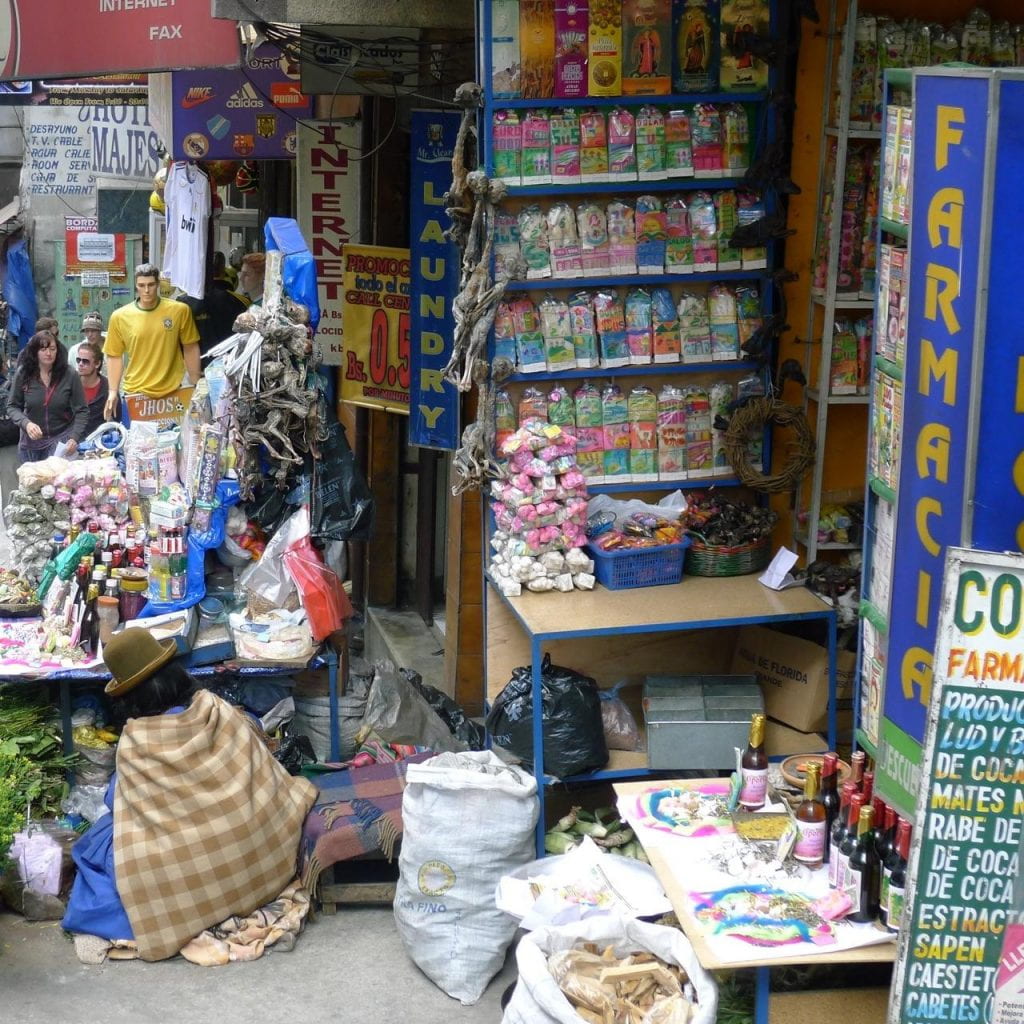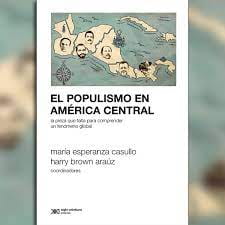Medical Practices in Bolivia
Indigenous, Western, or Natural?

Natural remedies, including many coca products, are sold at a street stand. Photo by Kate McGurn Cantellas
On the sixth floor of an older building in La Paz is a small office with a modest sign printed on standard computer paper. The dim light in the narrow hallway makes it difficult for me to read the sign. I notice a poster on the door advertising the “Primer Encuentro Nacional de Plantas Medicinales de Bolivia,” the First National Meeting on Bolivian Medicinal Plants, held in December 2010 under the sponsorship of this office. I’ve stumbled on the Vice Ministry of Traditional Medicine and Interculturality (Viceministerio de Medicina Tradicional e Interculturalidad), created by Evo Morales as part of the Ministry of Health and Sports shortly after his inauguration in 2006.
A middle-aged woman in Western clothing, drinking a cup of coca tea made from whole coca leaves, opens the door. Two men and another woman are there, one working at a computer propped on a small stand. Posters and informational materials cover the walls; bookshelves squeeze into a corner filled with binders, photocopied and spiral-bound informes, and locally-published books on indigenous medicine, medicinal plants and medical pluralism. It looks like a crowded, collegial office of a small but productive department at a university, or the location of an overworked but dedicated small NGO.
Everyone smiles at me and waits for me to say something. I nervously begin talking, rushing through the Spanish language formalities for greeting a group and trying to explain my presence in their office. “I, uh, am an anthropologist interested in pluralist forms of medicine and science in Bolivia. I’m doing research on the Bolivian system of science, technology and medicine. I’m, um, wondering if, uh, maybe your office has put out any kind of materials about what you do, or how you interact with Western forms of medicine or scientific research, or any kind of information, or um, if you know of anyone I can talk to….” I stumble through, still somewhat nervous and uncomfortable that I’ve interrupted teatime.
The woman who opened the door gives me a big smile and tells me that of course, it is our job to help you learn about what we do. You need to come back and talk to the Vice-Minister, but he’s out in the campo in Potosí in running a workshop (taller). Then one of the men joins in, telling me that the Vice-Minister is really busy but he’d like to talk to me. I ask what the office’s position is on working with biomedical institutions and practitioners. The same man makes a tent with his hands, interlacing his fingers. He tells me that they aim for “articulation” with Western medical traditions, and that they are engaged in a long process of dialog and integration with biomedical practitioners and institutions to achieve this.
What can we make of an official Vice-Ministry of Traditional Medicine (albeit one in cramped quarters, located some distance away from the Ministry of Health)? Does this hint at a new model—one that goes beyond medical pluralism, often institutionally understood as individual picking-and-choosing of health and medical philosophies. What would an “articulated” practice of intercultural health care look like? One of the Vice-Ministry’s aims is to ensure that traditional medicine in Bolivia is not an afterthought or a mere supplement to Western modes of healthcare. Under Evo Morales, institutional legitimacy has increasingly been given to traditional, indigenous and natural forms of medical practice. These terms are not identical in Bolivia. “Indigenous medicine” is the most specific; generally referring to healing practices that incorporate specific deities or cosmologies within healing rituals performed by specialized practitioners (such as yatiris). “Natural” medicine can mean anything from pills derived from natural products (for instance, lollipops made of honey and bee pollen to soothe coughs and sold in a jar on the counter of a pharmacy) to prescriptions from medical doctors to drink herbal teas and take probiotics for common stomach and respiratory ailments. Both emphasize herbalism. “Traditional” medicine is a term that encompasses both of these. Many middle-class, mestizo, urban Bolivians consult yatiris, integrate natural medicines into their medical practices and emphasize the healing power of Bolivian pharmacopeia.
Yet Western medicine is the dominant paradigm in major cities, though many poor and indigenous Bolivians view urban hospitals and clinics with suspicion. This is due to fear of the treatments provided, legacies of discrimination within the public hospital system, cost, and conflicting models of health and healing. Furthermore, supplies and equipment, especially in the public hospital and clinic system, are in short supply. Patients often need to provide their own bandages, syringes and other crucial items before receiving treatment.
Such structural factors have historically impeded access to healthcare for much of the urban population, and access is much worse for rural populations. Bolivia’s health indicators are still among the poorest in the Western hemisphere, according to the WHO.
Integrating the diverse knowledge traditions and reducing structural impediments to health care in Bolivia is the work of articulation. Articulation is a buzzword used, in conjunction with “interculturalidad,” to help define the vision of the Vice-Ministry, as explained on its website: to preserve and strengthen natural medicine and to formulate policy for a more equitable and intercultural health system.
This endeavor is not hierarchical, so that “traditional” practices, broadly defined, are viewed as equal to Western medicine in this interaction. Of course, there are knowledge and power hierarchies that predate the articulation model and will influence how smoothly and equally their application happens in practice. However, what is key here is that the model is supposedly non-hierarchical and takes knowledge claims of indigenous traditions as seriously as those of Western ones. For instance, when I inquired how articulation happens in Western-dominant spaces, I was told that a Kallawaya herbalist could be called in to consult for a patient hospitalized in a Western public hospital and would share his findings in a conference with the patient’s medical doctor. He would also perform specific rituals within the hospital.
Articulation seems to be required under an intercultural model: “interculturality” (an odd, awkward word in English) means that diverse and clearly defined cultures come together and interact. Articulation, the model for how this happens, is very different than, for instance, the “melting pot” ideology in the United States. Articulation does not imply the blurring of boundaries or the homogenization and blending of different groups into one national culture. Instead, there are separate spheres for different cultures, with interaction only occurring in these intercultural spaces (I’m picturing a Venn diagram with the overlap as intercultural space and the cultures or practices cleanly defined and separable).
This fits within the definition of Bolivia as a “pluralist” state. Pluralism in Bolivia as part of a (perhaps hegemonic) state project is evident across multiple domains of social life, at least rhetorically and officially: education, health, science policy, law, and so forth. Part of this project included the reorganization of government ministries and vice-ministries immediately following Morales’s inauguration to reflect indigenous traditions and practices. The emphasis on articulation makes sense considering the state is now being defined as comprised of many nations. Articulation in this model tries to level the playing field and allow for the public emergence and recognition of indigenous scientific and medical experts. It is linked to what I have discussed elsewhere as the emergence of a specific form of science in Bolivia I call “plural science” and to how different forms of expertise (what I call the construction of equivalency) are authorized and recognized in specific contexts. Yet it emphasizes separate and perhaps oppositional cultures within Bolivia, with little common ground beyond this intercultural space.
How effective this model will be in terms of breaking down barriers to effective health care, to providing space for indigenous medical traditions, and to improving Bolivia’s health indicators remains murky. It has the potential to move beyond individual choice models of medical pluralism and to provide a more holistic approach to medicine in Bolivia. It is also ideologically consistent with the pluralist project of Evo Morales and the “refounding” of the Bolivian state (with all of its concerns and inconsistencies). Yet it is still unclear how fully integrated this model will be by Western institutions. After all, the Vice-Ministry is located in a small office some distance from the Ministry of Health and Sports, which is perhaps symbolic of its relative distance from its more mainstream activities. The most recent informe of health indicators in Bolivia mentions traditional medicine only once in 162 pages: when it gave the name and title of the Vice Minister in an introductory page listing ministry officials.
Related Articles
A Review of Alberto Edwards: Profeta de la dictadura en Chile by Rafael Sagredo Baeza
Chile is often cited as a country of strong democratic traditions and institutions. They can be broken, however, as shown by the notorious civil-military dictatorship of Augusto Pinochet (1973-1990). And yet, even a cursory view of the nation’s history shows persistent authoritarian tendencies.
A Review of Born in Blood and Fire
The fourth edition of Born in Blood and Fire is a concise yet comprehensive account of the intriguing history of Latin America and will be followed this year by a fifth edition.
A Review of El populismo en América Latina. La pieza que falta para comprender un fenómeno global
In 1946, during a campaign event in Argentina, then-candidate for president Juan Domingo Perón formulated a slogan, “Braden or Perón,” with which he could effectively discredit his opponents and position himself as a defender of national dignity against a foreign power.




